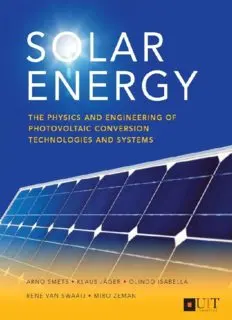
Solar Energy: The Physics and Engineering of Photovoltaic Conversion, Technologies and Systems PDF
Preview Solar Energy: The Physics and Engineering of Photovoltaic Conversion, Technologies and Systems
Solar energy The physics and engineering of photovoltaic conversion, technologies and systems Solar energy The physics and engineering of photovoltaic conversion, technologies and systems Arno HM Smets Klaus Jäger Olindo Isabella René ACMM van Swaaij Miro Zeman Contents Foreword Dean’s message Preface About this Book Nomenclature I Introduction 1 Energy 1.1 Some definitions 1.2 Human energy consumption 1.3 Methods of energy conversion 1.4 Exercises 2 Status and prospects of PV technology 3 The working principle of a solar cell II PV fundamentals 4 Electrodynamic basics 4.1 The electromagnetic theory 4.2 Electromagnetic waves 4.3 Optics of flat interfaces 4.4 Optics in absorptive media 4.5 Continuity and Poisson equations 4.6 Exercises 5 Solar radiation 5.1 The Sun 5.2 Radiometric properties 5.3 Blackbody radiation 5.4 Wave-particle duality 5.5 Solar spectra 5.6 Exercises 6 Basic semiconductor physics 6.1 Introduction 6.2 Atomic structure 6.3 Doping 6.4 Carrier concentrations 6.5 Transport properties 6.6 Exercises 7 Generation and recombination of electron-hole pairs 7.1 Introduction 7.2 Bandgap-to-bandgap processes 7.3 Shockley–Read–Hall recombination 7.4 Auger recombination 7.5 Surface recombination 7.6 Carrier concentration in non-equilibrium 7.7 Exercises 8 Semiconductor junctions 8.1 p-n homojunctions 8.2 Heterojunctions 8.3 Metal-semiconductor junctions 8.4 Exercises 9 Solar cell parameters and equivalent circuit 9.1 External solar cell parameters 9.2 The external quantum efficiency 9.3 The equivalent circuit 9.4 Exercises 10 Losses and efficiency limits 10.1 The thermodynamic limit 10.2 The Shockley-Queisser limit 10.3 Additional losses 10.4 Design rules for solar cells 10.5 Exercises III PV technology 11 A short history of solar cells 12 Crystalline silicon solar cells 12.1 Crystalline silicon 12.2 Production of silicon wafers 12.3 Designing c-Si solar cells 12.4 Fabricating c-Si solar cells 12.5 High-efficiency concepts 12.6 Exercises 13 Thin-film solar cells 13.1 Transparent conducting oxides 13.2 The III-V PV technology 13.3 Thin-film silicon technology 13.4 Chalcogenide solar cells 13.5 Organic photovoltaics 13.6 Hybrid organic-inorganic solar cells 13.7 Exercises 14 A closer look to some processes 14.1 Plasma-enhanced chemical vapour deposition 14.2 Physical vapour deposition 14.3 Screen printing technology 14.4 Electroplating technology 15 PV modules 15.1 Series and parallel connections in PV modules 15.2 PV module parameters 15.3 Bypass diodes 15.4 Fabrication of PV modules 15.5 PV module lifetime testing 15.6 Thin-film modules 15.7 Some examples 15.8 Concentrator photovoltaics (CPV) 15.9 Exercises 16 Third generation concepts 16.1 Multi-junction solar cells 16.2 Spectral conversion 16.3 Multi-exciton generation 16.4 Intermediate band solar cells 16.5 Hot carrier solar cells 16.6 Exercises IV PV systems 17 Introduction to PV systems 17.1 Introduction 17.2 Types of PV systems 17.3 Components of a PV system 17.4 Exercise 18 Location issues 18.1 The position of the Sun 18.2 Irradiance on a PV module 18.3 Direct and diffuse irradiance 18.4 Exercise 19 Components of PV systems 19.1 Maximum power point tracking 19.2 Power electronics 19.3 Batteries 19.4 Charge controllers 19.5 Cables 19.6 Exercises 20 PV system design 20.1 A simple approach for designing stand-alone systems 20.2 Load profiles 20.3 Meteorological effects 20.4 Designing grid-connected PV systems 20.5 Designing stand alone PV systems 20.6 Exercises 21 PV system economics and ecology 21.1 PV system economics 21.2 PV system ecology 21.3 Exercises V Alternative solar energy conversion technologies 22 Solar thermal energy 22.1 Solar thermal basics 22.2 Solar thermal heating 22.3 Concentrated solar power (CSP) 22.4 Exercises 23 Solar fuels 23.1 Electrolysis of water 23.2 Photoelectrochemical (PEC) water splitting 23.3 Exercises Appendix A Derivations in electrodynamics A.1 The Maxwell equations A.2 Derivation of the electromagnetic wave equation A.3 Properties of electromagnetic waves B Derivation of homojunction J-V curves B.1 The J-V characteristic in the dark B.2 J-V characteristic under illumination C Some aspects of surface recombination C.1 Infinite surface recombination velocity S C.2 Surface recombination velocity S = 0 C.3 Open circuit voltage for p-n junction solar cells D The morphology of selected TCO samples D.1 Surface parameters D.2 Examples E Some aspects on location issues E.1 The position of the Sun E.2 The equation of time E.3 Angle between the Sun and a PV module E.4 Modules mounted on a tilted roof E.5 Length of the shadow behind a PV module F Derivations for DC-DC converters F.1 Buck converter F.2 Boost converter F.3 Buck-boost converter G Fluid-dynamic model G.1 Framework of the fluid-dynamic model G.2 Convective heat transfer coefficients G.3 Other parameters G.4 Evaluation of the thermal model Bibliography Index
